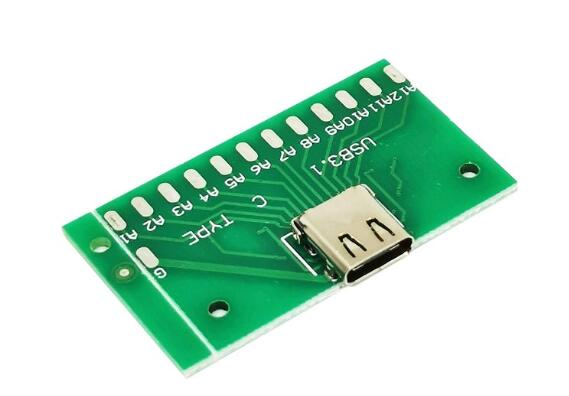The PCB breakout board is a special motherboard mainly used for Industrial PC to help deal with industrial projects.It is possible to use a high level, low level or any other level control mode for the breakout board. Select whether a fully isolated breakout board is required according to the requirements.

The main function of the breakout board is to convert the rotational motion of the motor into linear motion. Relay modules often use ball screws or grinding screws. The rolling friction between the ball screw and the nut is formed by the steel ball, which has smooth movement, high transmission efficiency, and easy-to-achieve high-speed operation. The diameter of the steel ball can be changed or double nuts can be used to effectively solve the axial clearance.
PCB breakout board structure
The PCB breakout board is set between the components and the circuit board, with metal rewiring (RDL) distributed on the upper and lower surfaces. After packaging, the components are generally connected to the adapter board through flip soldering, and the breakout board is connected to the PCB below through BGA at the board level. The PCB breakout board serves as an intermediary bridge between components and circuit boards and can interconnect multiple chips through RDL, as well as between chip components and circuit boards.
Advantages of breakout board
1. High-density I/O interconnection. With the rapid increase in interconnect density and I/O quantity, the pitch of metal protrusions required for flip-flop welding continues to decrease, leading to significant challenges in production costs and manufacturing difficulties for metal protrusions. The breakout board utilizes RDL layers with small linewidth and high-density wiring to achieve redistribution of high-density I/O, thereby reducing the requirement for pitch bumps. TSV-based breakout boards can redistribute high-density I/O on the back of the breakout board, while shortening the interconnection length between chips and circuit boards, reducing power consumption and latency.
2. Improve integration. The RDL line width on the breakout board is small and the wiring density is large, which can improve the system integration. Although the system area has increased and the integration degree is relatively small compared to 3D integration, compared to the wire bonding method, the PCB breakout board can improve the integration degree and reduce the system area to a certain extent.
3. Heterogeneous integration. The breakout board can encapsulate chips with different functions, processes, and substrates, achieving heterogeneous integration of the system and increasing its functionality.
Classification of breakout boards
The breakout boards can be divided into inorganic and organic adapter plates according to the material, and the inorganic breakout boards mainly include silicon, ceramic, and glass breakout boards; In addition, according to whether there is TSV on the adapter board, the adapter board can be divided into TSV adapter board and TSV free breakout boards.
1. Organic breakout boards: Low manufacturing cost and low manufacturing process difficulty. However, the organic breakout boards have a large coefficient of thermal expansion (CTE) and poor dimensional stability, resulting in limited interconnect line width and I/O density; In addition, organic matter has low thermal conductivity and poor heat dissipation performance; Moreover, the organic breakout boards has a small elastic modulus and is prone to warping during the manufacturing process.
2. Ceramic breakout boards: It has good dimensional stability, high thermal conductivity, and good heat dissipation performance, but the I/O density of the ceramic adapter plate is limited, resulting in high manufacturing costs and difficulty.
3. Silicon breakout board: With good dimensional stability, it can achieve small line width, small pitch, and high-density wiring. But the manufacturing cost of silicon breakout board is high, and the transmission loss is high at high frequencies.
4. Glass breakout board: With good insulation and isolation, it can effectively reduce insertion loss and crosstalk at high frequencies; At the same time, the thermal expansion coefficient of glass is adjustable, which can reduce the thermal mismatch with different materials. However, glass is brittle, has low thermal conductivity, poor heat dissipation performance, and it is difficult to manufacture holes with small apertures and large aspect ratios.
5. Silicon-based breakout board with TSV: Currently, it has received widespread attention in high-end packaging. The RDL line width of the silicon-based breakout board is less than 1um, and the TSV is 50:5, which can achieve small line width, small pitch, and high-density wiring. TSV's CoWoS (Chip on Wafer on Substrate) was the first to introduce the silicon-based breakout board to commercial applications. The HPC package based on TSV's silicon breakout board can integrate High-performance computing chips and memory chips into one package, reducing power consumption by 50% and improving performance by three times.
6. Organic breakout boards without TSV: Generally, the interconnection density is low, and it is necessary to increase local interconnection through embedded silicon bridges. The embedded multi-chip bridge (EMI B) developed by Intel is a typical example. By embedding a high-density RDL silicon breakout board in an organic breakout board, the interconnection between multiple chips is achieved while reducing production costs. This technology has been used in i7-8809G, where the GPU and HBM are connected through a silicon bridge.
The PCB breakout board is a special motherboard mainly used for Industrial PC to help deal with industrial projects. The industrial control motherboard is a card-shaped composite board, which, like the commercial motherboard, is filled with various industrial components and various sockets. From the perspective of the board type, the breakout board is relatively small and has multiple RS232 serial ports or RS485/422 ports, or multiple LAN network ports. The breakout board uses low-power chips to save energy High temperatures and other issues that occur during prolonged operation.